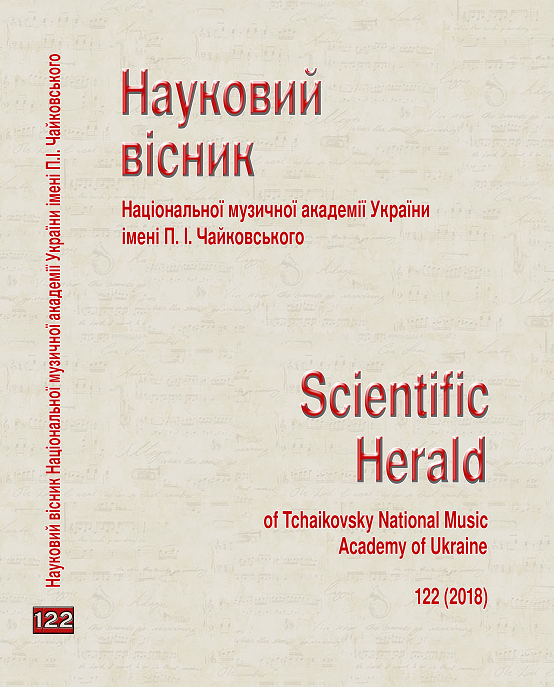Specificity of Performance Interpretation of Hennady Liashenko`s Quartet №1
DOI:
https://doi.org/10.31318/2522-4190.2018.122.141808Keywords:
quartet, expression means, neo-folklorism, a legacy of H. LiashenkoAbstract
The relevance of the investigation. For the first time in Ukrainian music studies, the partiture of a famous Ukrainian composer H. Liashenko is studied. In the case of the partiture, the peculiarities of interpretation of linguistic, figurative system, specifics of musical form are investigated. In the article, it is stated, that the main stylistics method of the quartet is a neo-folkloric performance tendency. The genre and stylistic features of the work have been studied by the method of integral musical and theoretical analysis, the figurative content of the quartet has been determined, the features of the formation and use of compositional means of expressiveness (intonational structure of the main elements of the form, methods of development of the thematic material) have been revealed. Complex interpretation analysis is used in studying the peculiarities of the use of quartet performing expressive means (articulation, strokes, vibration) in their interaction with compositional means. Various forms of vibrato in the quartet score have been studied, which deepens the notion of the characteristic of the timbre of string-bow instruments and contributes to the life-like colorful sound of the quartet ensemble.
Conclusions. Different expedients of cantilena sound in Quartet №1, borrowings of folk performance manner coexist with specific and detailed timbral and dashed differentiation of quartet performance. Amid them there is vibrato technique as well, as it is an important mean of musical expression of a quartet performer. The practical implications of results of the given work are in the field of usage in the real quartet class, as well as in educative classes or workshops concerning with quartet methodology and performance history of bow instruments.
Downloads
References
Andriievskyi, I. (1999), “Problems of Folklore and Contemporary Ukrainian Violin School”, Naukovyj Visnyk Nacionaljnoji muzychnoji akademiji Ukrajiny imeni P.I.Chajkovsjkogho [Scientific Bulletin of the National music academy of Ukraine named after P. I. Tchaykovsky], vol. 1, Kyiv, pp. 85-96 [in Ukrainian].
Raaben, L. (1983), “New in Soviet Music of the 70s”, Sovremennyie problemyi sovetskoy muzyiki [Modern Problems of Soviet Music], LGK, Leningrad, p. 9-23 [in Russian].
Feshchak, N. (2009), “Vibration as a medium of expression in quartets by H. Liashenko and Ye. Stankovych”, Mystectvoznavchi zapysky [Art-Studies Notes], vol. 15, p. 37-44 [in Ukrainian]
Downloads
Published
How to Cite
Issue
Section
License
Our journal abides by the CREATIVE COMMONS copyright rights and permissions for open access journals.
Authors, who are published in this journal, agree to the following conditions:
The authors reserve the right to authorship of the work and pass the first publication right of this work to the journal under the terms of a Creative Commons Attribution License, which allows others to freely distribute the published research with the obligatory reference to the authors of the original work and the first publication of the work in this journal.
The authors have the right to conclude separate supplement agreements that relate to non-exclusive work distribution in the form in which it has been published by the journal (for example, to upload the work to the online storage of the journal or publish it as part of a monograph), provided that the reference to the first publication of the work in this journal is included.




